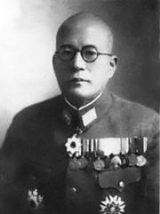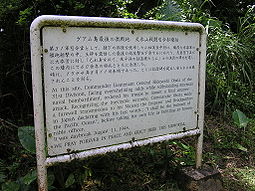
Hideyoshi Obata
Encyclopedia
was a general in the Imperial Japanese Army
in World War II
.
. He graduated from the 23rd class of the Imperial Japanese Army Academy in December 1911, and was commissioned as a lieutenant
in the cavalry
. In 1919, he graduated from the 31st class of the Army War College
and was promoted to the rank of captain in the cavalry.
Attracted to right-wing nationalist politics in his youth, he was a member of the radical Imperial Way Faction
, under the leadership of Sadao Araki
, against the more moderate Toseiha
of Kazushige Ugaki.
From 1923-1927, Obata was assigned as a military attaché
to the United Kingdom
and from 1927-1934 as military attaché to British India. In August 1934, he was promoted to colonel
in the cavalry and recalled to Japan for staff postings within the Imperial Japanese Army General Staff.
Obata was promoted to major general
in March 1938, and was reassigned from cavalry to army aviation
. He was appointed Commandant of the Akeno Army Air School in August 1938. In December 1940, he was promoted to lieutenant general
and commander of the IJA 5th Air Group in Taiwan
at the start of the Pacific War
. His command was subsequently assigned to the Burma front in 1942. In May 1943, he became commander in chief of the IJA 3rd Air Army but was recalled to Tokyo
in December.
On 18 February 1944, Obata was assigned command of the Thirty-First Army (Japan)
, with the IJA 29th Division and IJA 53rd Division in charge of the defense of the Mariana Islands
from the approaching Allied forces
. He was away from his headquarters on Saipan
at the time of the American invasion and established his new command post on Guam
. However, at the Battle of Guam he was soon overwhelmed by superior American numbers and firepower, and after giving the order that his forces should fight to the death, he committed seppuku
on 11 August 1944. Obata was promoted posthumously to the rank of general
.

Imperial Japanese Army
-Foundation:During the Meiji Restoration, the military forces loyal to the Emperor were samurai drawn primarily from the loyalist feudal domains of Satsuma and Chōshū...
in World War II
World War II
World War II, or the Second World War , was a global conflict lasting from 1939 to 1945, involving most of the world's nations—including all of the great powers—eventually forming two opposing military alliances: the Allies and the Axis...
.
Biography
Obata was a native of Osaka prefectureOsaka Prefecture
is a prefecture located in the Kansai region on Honshū, the main island of Japan. The capital is the city of Osaka. It is the center of Osaka-Kobe-Kyoto area.- History :...
. He graduated from the 23rd class of the Imperial Japanese Army Academy in December 1911, and was commissioned as a lieutenant
Lieutenant
A lieutenant is a junior commissioned officer in many nations' armed forces. Typically, the rank of lieutenant in naval usage, while still a junior officer rank, is senior to the army rank...
in the cavalry
Cavalry
Cavalry or horsemen were soldiers or warriors who fought mounted on horseback. Cavalry were historically the third oldest and the most mobile of the combat arms...
. In 1919, he graduated from the 31st class of the Army War College
Army War College (Japan)
The ; Short form: of the Empire of Japan was founded in 1882 in Minato, Tokyo to modernize and Westernize the Imperial Japanese Army. Much of the empire's elite including prime ministers during the period of Japanese militarism were graduates of the college....
and was promoted to the rank of captain in the cavalry.
Attracted to right-wing nationalist politics in his youth, he was a member of the radical Imperial Way Faction
Imperial Way Faction
The was a political faction in the Imperial Japanese Army, active in the 1920s and 1930s and largely supported by junior officers aiming to establish a military government, that promoted totalitarian, militarist, and expansionist ideals...
, under the leadership of Sadao Araki
Sadao Araki
Baron was a general in the Imperial Japanese Army before World War II. A charismatic leader and one of the principal nationalist right-wing political theorists in the late Japanese Empire, he was regarded as the leader of the radical faction within the politicized Japanese Army and served as...
, against the more moderate Toseiha
Toseiha
' was a political faction in the Imperial Japanese Army, active in the 1920s and 1930s.Led by General Kazushige Ugaki, along with Hajime Sugiyama, Koiso Kuniaki, Yoshijirō Umezu, Tetsuzan Nagata and Hideki Tōjō, the Tōseiha was a grouping of officers united primarily by their opposition to the...
of Kazushige Ugaki.
From 1923-1927, Obata was assigned as a military attaché
Military attaché
A military attaché is a military expert who is attached to a diplomatic mission . This post is normally filled by a high-ranking military officer who retains the commission while serving in an embassy...
to the United Kingdom
United Kingdom
The United Kingdom of Great Britain and Northern IrelandIn the United Kingdom and Dependencies, other languages have been officially recognised as legitimate autochthonous languages under the European Charter for Regional or Minority Languages...
and from 1927-1934 as military attaché to British India. In August 1934, he was promoted to colonel
Colonel
Colonel , abbreviated Col or COL, is a military rank of a senior commissioned officer. It or a corresponding rank exists in most armies and in many air forces; the naval equivalent rank is generally "Captain". It is also used in some police forces and other paramilitary rank structures...
in the cavalry and recalled to Japan for staff postings within the Imperial Japanese Army General Staff.
Obata was promoted to major general
Major General
Major general or major-general is a military rank used in many countries. It is derived from the older rank of sergeant major general. A major general is a high-ranking officer, normally subordinate to the rank of lieutenant general and senior to the ranks of brigadier and brigadier general...
in March 1938, and was reassigned from cavalry to army aviation
Army aviation
Army Aviation refers to aviation-related units of a nation's army, often described as an air corps. These units are generally separate from a nation's dedicated air force, and usually comprise helicopters and light support fixed-wing aircraft....
. He was appointed Commandant of the Akeno Army Air School in August 1938. In December 1940, he was promoted to lieutenant general
Lieutenant General
Lieutenant General is a military rank used in many countries. The rank traces its origins to the Middle Ages where the title of Lieutenant General was held by the second in command on the battlefield, who was normally subordinate to a Captain General....
and commander of the IJA 5th Air Group in Taiwan
Taiwan
Taiwan , also known, especially in the past, as Formosa , is the largest island of the same-named island group of East Asia in the western Pacific Ocean and located off the southeastern coast of mainland China. The island forms over 99% of the current territory of the Republic of China following...
at the start of the Pacific War
Pacific War
The Pacific War, also sometimes called the Asia-Pacific War refers broadly to the parts of World War II that took place in the Pacific Ocean, its islands, and in East Asia, then called the Far East...
. His command was subsequently assigned to the Burma front in 1942. In May 1943, he became commander in chief of the IJA 3rd Air Army but was recalled to Tokyo
Tokyo
, ; officially , is one of the 47 prefectures of Japan. Tokyo is the capital of Japan, the center of the Greater Tokyo Area, and the largest metropolitan area of Japan. It is the seat of the Japanese government and the Imperial Palace, and the home of the Japanese Imperial Family...
in December.
On 18 February 1944, Obata was assigned command of the Thirty-First Army (Japan)
Thirty-First Army (Japan)
The was an army of the Imperial Japanese Army during World War II.-History:The Japanese 31st Army was formed on February 18, 1944 under the Imperial General Headquarters as a garrison force to contest landings by Allied forces in the Japanese South Seas Mandate island-by-island, and to inflict...
, with the IJA 29th Division and IJA 53rd Division in charge of the defense of the Mariana Islands
Mariana Islands
The Mariana Islands are an arc-shaped archipelago made up by the summits of 15 volcanic mountains in the north-western Pacific Ocean between the 12th and 21st parallels north and along the 145th meridian east...
from the approaching Allied forces
Allies of World War II
The Allies of World War II were the countries that opposed the Axis powers during the Second World War . Former Axis states contributing to the Allied victory are not considered Allied states...
. He was away from his headquarters on Saipan
Saipan
Saipan is the largest island of the United States Commonwealth of the Northern Mariana Islands , a chain of 15 tropical islands belonging to the Marianas archipelago in the western Pacific Ocean with a total area of . The 2000 census population was 62,392...
at the time of the American invasion and established his new command post on Guam
Guam
Guam is an organized, unincorporated territory of the United States located in the western Pacific Ocean. It is one of five U.S. territories with an established civilian government. Guam is listed as one of 16 Non-Self-Governing Territories by the Special Committee on Decolonization of the United...
. However, at the Battle of Guam he was soon overwhelmed by superior American numbers and firepower, and after giving the order that his forces should fight to the death, he committed seppuku
Seppuku
is a form of Japanese ritual suicide by disembowelment. Seppuku was originally reserved only for samurai. Part of the samurai bushido honor code, seppuku was either used voluntarily by samurai to die with honor rather than fall into the hands of their enemies , or as a form of capital punishment...
on 11 August 1944. Obata was promoted posthumously to the rank of general
General
A general officer is an officer of high military rank, usually in the army, and in some nations, the air force. The term is widely used by many nations of the world, and when a country uses a different term, there is an equivalent title given....
.


